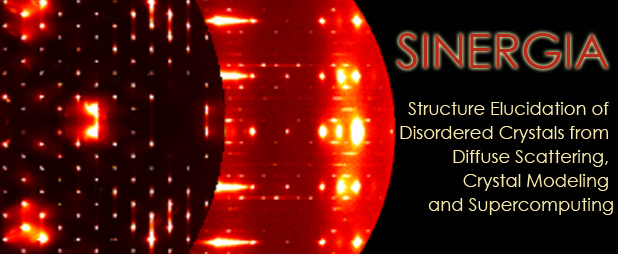
News & Events
Kick Off Meeting
6-10 July 2009
Annual Meeting OakRidge
6-10 April 2010
Annual Meeting UZH
15-17 September 2010
Annual Meeting
11- 19 April 2011
Sinergia Project Overview
The primary focus of this proposal is structure elucidation at the nano- to micrometer length scales for materials that exhibit interesting properties due to a lack of structural order. The plan is to build efficient and conceptually revolutionized software for interpreting diffuse neutron and X-ray scattering data, taking advantage of supercomputing facilities.
The main objective of this proposal is to transform current heuristic approaches for analyzing the total, three-dimensional (3D) diffraction pattern of solid-state materials into a unified, efficient and conceptually revolutionized computational method that capitalizes on (a) advances in synchrotron and neutron physics, (b) a new crystallographic description of disordered structures, (c) progress in modeling molecular and other materials, and (d) new technologies in large-scale computing.
The project is a multi-disciplinary and international team effort between the University of Zürich, ETH Zürich and Oak Ridge National Laboratory (ORNL). The project has been motivated by the new single-crystal diffraction facility TOPAZ (scheduled for commissioning early in 2009) at the Spallation Neutron Source (SNS) at ORNL1 and by the technical innovations planned for the upgrade of the European Synchrotron Radiation Facility (ESRF) in Grenoble, France. X-ray and neutron scattering are the two most important methods for elucidating the structure of crystalline materials at the atomic length scale. In addition to Bragg intensities, associated with the space-time-average crystal structure, experiments at these state-of-the-art installations can also detect weak, highly resolved diffuse scattering signals, whose distribution carries information on static and dynamic structural fluctuations in the nanometer range. Recent studies by our team illustrate that the combination of graph theoretical and symmetry aspects with molecular modeling, genetic algorithms (GA), Monte Carlo (MC) simulations and massive computing has the potential of bringing about a paradigm change in structure determination and optimization of disordered materials. We will design efficient computer programs and associated analysis protocols adapted to the world-class high-performance computing facility of the National Center for Computational Sciences (NCCS) at ORNL and the grid computing facility associated with the Institute of Organic Chemistry of the University of Zürich (IOC at UZH). The software will be available freely to the respective user communities.

ABOUT US

Zurich Team:
|
OakRidge Team: |
Kim Baldridge Prof. of Theoretical Chemistry and Computational Grid Applications |
Christina Hoffmann Project Manager, TOPAZ Instrument Group |
Hans-Beat Bürgi Prof. of Chemistry |
Stephen Miller Scientific Computing Group Leader, NSSD, ORNL |
Tony Linden wissenschaftlicher Mitarbeiter mbA and Privatdozent |
Tibor Koritsanszky Prof. of Physical Chemistry |
Thomas Weber PhD |


